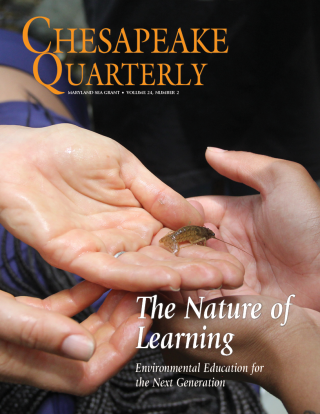The Maryland Sea Grant Bookstore will be closed for the winter holidays from Monday, December 15th to Friday, January 2nd and will not be taking orders during that time.
Always, sometimes, or rarely inundated?
Exploration
Students will now begin manipulating actual data from a tidal freshwater marsh. The marsh used in this lesson is Dyke Marsh, located near Alexandria, Virginia, on the Potomac River. Another tidal freshwater marsh can be used if tidal, elevation, and vegetation information can be acquired for the marsh.
This phase of the lesson can be divided into three sections. First, students use elevation data to create a topographic profile that will help them visualize the different levels within the marsh. Next, they will use tidal data to determine the relative amount of time that these levels are inundated by water. Finally, they will use this information to determine what types of plant communities would be found in the different areas of the marsh.
Objectives
Using elevation data of a tidal freshwater marsh, students will create a topographic profile of one section of the marsh. Using tidal data for a tidal freshwater marsh, students will determine the relative amount of time that different sections of the marsh are inundated with water. Using descriptions of various wetland plants, students will determine at which elevation level(s) these plants would establish communities within a tidal marsh.
Lesson Materials
Elevation data and tidal data for Dyke Marsh or another freshwater tidal marsh
Pictures and descriptions of wetland plants found in Dyke Marsh or another tidal freshwater marsh
Graph paper
Rulers
Calculators
Colored pencils
Procedures
1. Define the terms elevation and transect. Give each student a copy of the elevation data for one transect of Dyke Marsh. (If an alternate tidal freshwater marsh is being used, this data will need to be organized in a table before beginning the lesson. The elevation should vary along the transect to give the best results.)
2. The students should use the elevation data to create a topographic profile of the marsh transect. (The profile can be done using pencil and paper or on a computer using graphing software.)
3. Define the terms "topographic profile," "mean high water," and "mean low water." Introduce tidal data for the marsh for a specific time period (about one week of data.)
4. Ask the students to calculate the average high tide and low tide to determine the mean high water (MHW) line and the mean low water (MLW) line. The students should mark both lines on their profiles by drawing a line from the respective elevation on their profile down to the x-axis.
5. NOAA provides real-time tidal data for various locations throughout the world at http://tidesonline.nos.noaa.gov/. Define the term intertidal zone.
6. Next, the students will divide their topographic profiles into 3 categories: always inundated (below MLW), sometimes inundated (between MLW and MHW), or rarely inundated (above MHW.) Ask the students to shade each section a different color. Students should also add a key to their profile.
7. Provide students with information about several wetland plants that inhabit the marsh. This information should include a picture of the plant and how much water inundation it can withstand or prefers.
8. The students should use this information to determine on their topographic profiles where they would expect to find each type of plant. Ask the students to write the name of the plant and draw it in the correct location.
References
National Oceanic and Atmospheric Administration Tides Online, http://tidesonline.nos.noaa.gov/





